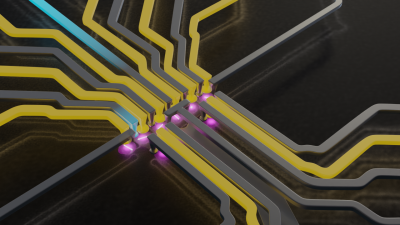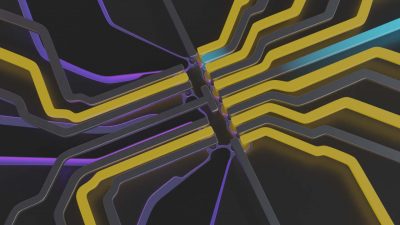
HRL Laboratories to Share Silicon Qubit Technology
Through Partnership with the Laboratory for Physical Sciences’ Qubit Collaboratory, HRL Will Distribute Silicon Quantum-Dot Devices for Academic and Government Research
MALIBU, Calif. June 15, 2023— HRL Laboratories, LLC is partnering with the Laboratory for Physical Sciences’ Qubit Collaboratory to fabricate cutting-edge silicon quantum dot devices for distribution to academic and government researchers. The effort aims to democratize access to next-generation quantum dot technology to accelerate discovery in quantum science.
Silicon quantum dots are cryogenic semiconductor nanodevices that trap single electrons and are promising candidates for quantum information processing applications. However, technology development has increasingly been hampered in many research settings by fabrication difficulties. Future research goals call for much more sophisticated devices that are impractical or impossible to manufacture without state-of-the-art facilities, such as those at HRL. 
“We are extremely excited to get our devices into the hands of some of the most talented researchers in the world,” said Dr. Matthew Reed, manager of the effort at HRL. “The combination of HRL’s fabrication and test expertise with the creativity and diversity of academia should kick off a flurry of scientific achievement. We hope this collaboration dramatically raises interest in quantum science using silicon quantum dots.”
The first devices will be shipping this month to the research groups of Prof. Jason Petta at UCLA and Prof. Mark Eriksson at the University of Wisconsin, both preeminent researchers in the field. The program will later expand support to a broader community including scientists working in adjacent fields like superconducting qubits and investigators beginning their careers.
A world leader in quantum dot technologies, HRL will be providing devices based on its SLEDGE technology (https://pubs.acs.org/doi/abs/10.1021/acs.nanolett.1c03026). Such devices separate the nanoscale electrical contacts that form the quantum dots from the wires that route those gates to macroscopic bond pads. Distinct fabrication of the “front end” and “back end” is common in scaled semiconductor technologies but had not previously been deployed in quantum dots. This separation enables more sophisticated arrangements of dots, making devices more robust and capable. SLEDGE devices were used in HRL’s demonstration of universal control of two exchange-only qubits, recently published in Nature magazine (https://www.nature.com/articles/s41586-023-05777-3).
Another key advantage of SLEDGE is its flexibility, enabling changes in gate dimensions, material selection, and the addition of features such as micromagnets with minimal process development. Later in the Foundry project, devices will therefore be customizable according to collaborators’ specific needs.
“There are still many problems to solve and many types of qubits to explore,” said Charles Tahan, Director of the LPS Qubit Collaboratory. “By bringing working devices to more research groups across the country, we can accelerate the pace of discovery. We are proud to facilitate that through the Qubits for Computing Foundry program in support of the U.S. National Quantum Initiative.”
HRL Laboratories, LLC, California (hrl.com) pioneers the next frontiers of physical and information science. Delivering transformative technologies in automotive,aerospace and defense, HRL advances the critical missions of its customers. As a private company owned jointly by Boeing and GM, HRL is a source of innovations that advance the state of the art in profound and far-reaching ways.
Media Inquiries: media[at]hrl.com, (310) 317-5000

